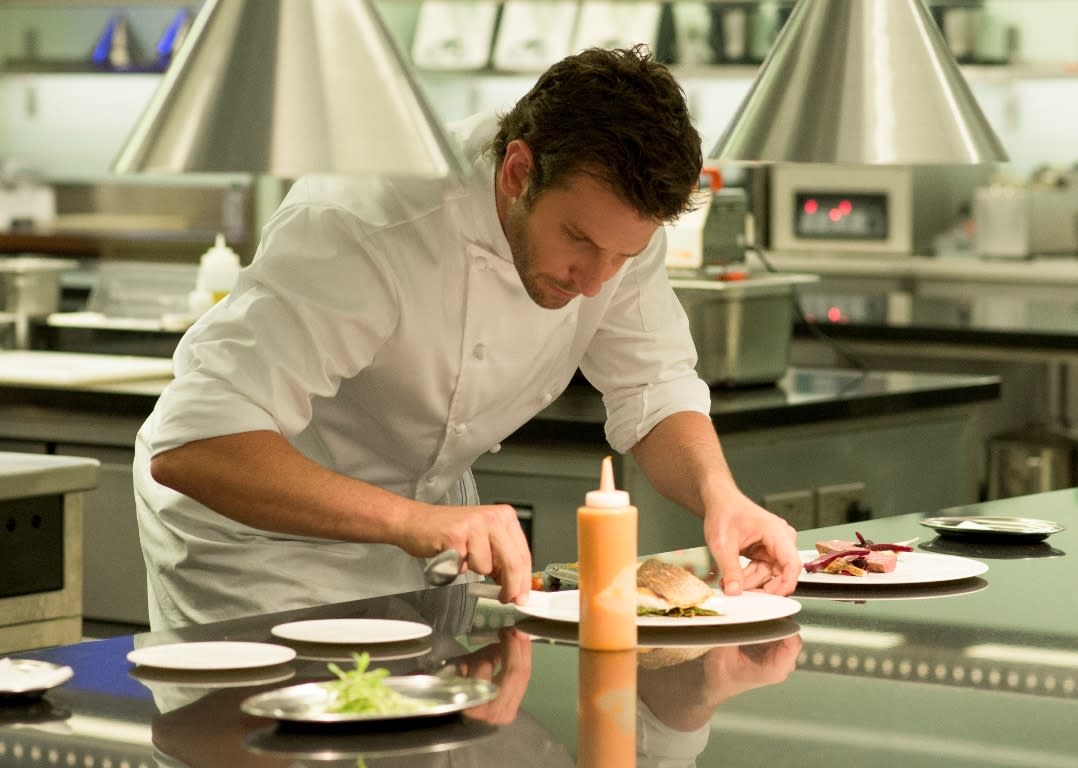5 Reasons Why the Culinary Skills and Restaurant Drama in ‘Burnt’ Look So Real

Bradley Cooper in “Burnt”; Photo: The Weinstein Company
Acting chops aren’t the only knife skills the cast of “Burnt” needed for the upcoming movie about a hot-headed chef. The cast and crew of the film, which features Bradley Cooper and Sienna Miller, did a lot of work to make sure the intensity and demands of a kitchen came through. The film tells the story of a self-destructive chef setting out to open a new restaurant and earn an elusive third Michelin star from the gastronome guide. Here are five ways the film made it just like the real deal.
1. Learning From a Pro
The cast and crew endured intense culinary training from Michelin-starred British chef Marcus Wareing in order to make the kitchen scenes realistic and the cuisine mouthwatering.
“I learned about knife skills and filleting,” Miller said at a screening of the film during the New York City Wine and Food Festival where real-life culinary stars were in attendance, including Daniel Boulud and Martha Stewart. “I can now cook fish quite well,” Miller said. “I was taught by one of the best in the world.”
MORE: The 15 Greatest Moments of Anthony Bourdain’s TV Career, Ranked
2. Real-World Experience
Cooper also had some real-world kitchen experience to rely on before getting a primer in fine dining. When he was younger, he worked as a prep cook at an Italian seafood restaurant in Somers Point, N.J.
“I remember the chef was 21 years old and he had just gotten back from Paris and he was so full of ideas — and arrogant,” Cooper said. “I spent all day long with him and he taught me so much. I became kind of obsessed with that world.”

Director Jim Wells and actress Sienna Miller at a screening of “Burnt” for chefs during the New York City Wine and Food Festival; photo: Getty Images for NYCWFF
3. Due Diligence
Director John Wells spent six months exploring the kitchens of high-end restaurants, including Mario Batali’s Babbo and Del Posto. Batali is credited as a culinary consultant for the film.
MORE: Life-Changing Lessons from Jacques Pépin
4. Many Cooks in the Kitchen
In the kitchen, every actor who doesn’t have a speaking roll is a chef at a Michelin-starred restaurant, and Wareing was on set to design dishes. Every dish shown is real food, and Wells estimated between 100 and 110 meals came out of the kitchen every day during filming.
“It was all real food; we threw a lot of it away and it was really depressing,” Wells said. Cooper said they did at least eat some of the food between takes because the catering wasn’t the best.
5. Legit Kitchen
Making the film still more realistic is that most scenes were shot in a kitchen built in a London studio modeled after the real kitchen at Roux at the Landau, the restaurant of the Langham hotel.
“It’s a dream for actors because we were behaving. We were executing what we were trained. There were 15-minute takes where I would read out orders and they’d have to deliver at the pass at the right time so I could plate the food,” Cooper said. “Marcus [Wareing] was wearing a thermometer and watching and all the other chefs were actual chefs. So we had a lot of pressure.”
MORE: Famed Chef Daniel Boulud Explains What Really Happened on ‘Letterman’

Bradley Cooper at a screening of “Burnt” for chefs during the New York City Wine and Food Festival; photo: Getty Images for NYCWFF
At one point in the film, the pressure mounts so much that Cooper’s character Adam Jones throws a massive tantrum — but it was still tamer than some blowups that the cast and director witnessed while researching the film.
“I saw someone burn someone else with a spatula that looked like it was on purpose,” Wells said. “Someone else got hit in the face with a hot steak because they got the count wrong.”
Miller chimed in that she witnessed a chef take two pieces of bread and put them alongside a cook’s head to make an “idiot sandwich.”
But despite the outbursts, the cast said they have more respect than ever for the high-pressure world of fine dining, and now even approach dining out differently.
For example, Miller said she learned that if someone leaves the table to use the restroom when everybody’s food is ready, they’ll throw it out if it takes longer than 3 minutes.
“If I’m at a posh place with friends, no one can pee,” she said laughing. “You have no idea so there should be a leaflet that goes out to people. I’m really a conscientious diner now.”

